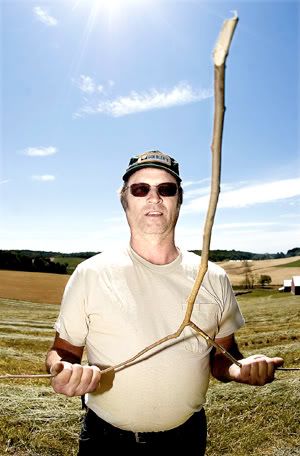First I should probably describe what a dowsing rod looks like. There are a few varieties.
The first one that I'll describe is the one I'm most familiar with and I think the one least prone to human error and/or faking.
 (This image is taken from "The Rock Town Weekly.")
(This image is taken from "The Rock Town Weekly.")This is one way to hold a dowsing rod when dowsing for water, oil, or minerals. There are other, more awkward, ways to hold it to further insure that the user can't manipulate the rod himself.
Usually the objective is the find water, thus the name "water witching." I think the 'witching' part has more to do with witch hazel being the traditional wood used rather than any association with actual witches.
It must be made clear that I do not consider this variety of dowsing to be supernatural in nature. It has been given supernatural overtones, however, by the use of prayers to 'influence' the actions of the rods and other rituals. This is a grave error and is why, I think, most Catholic resources put together by the laity say that dowsing rods should not be used.
Also, though it has been used for such, do not use a dowsing rod of any variety to look for lost objects. The traditional use of a dowsing rod is searching out the geological location of water, oil, or minerals. Just being lost doesn't make an item unique enough to trigger any sort of reaction by a non-intelligent object and therefore any reactions that do occur should be suspect!
There, I used an exclamation mark. It's a very important point and I think it deserves the emphasis.
 (This image is from "UK Skeptics.">
(This image is from "UK Skeptics.">This is probably the most popular type of dowsing rod and is used not only for water witching but also the detection and communication with spirits. They are often sold along side pendulums of various mysterious shapes and may come with books on the paranormal and spirit communication. The idea is that they will cross, like in the picture, when near a supernatural 'entity.' In communication with such entities the position of the rods indicates either a 'yes' or 'no' answer. The user often states which position is which before asking the question.
What they actually are is a pair of metal (usually brass) rods bent in the shape of an L. The short bit, which is grasped, may of may not have comfortable wood handle covers.
Assuming, as most ghost hunters do, that spirits and other paranormal phenomena are accompanied by strong elector-magnetic fields, the copper rods actually makes some sense. Brass is an alloy of copper and zinc, and copper is, after all, used in electrical wiring. Depending on the proportion of copper (and perhaps the addition of silver) used, brass can be an excellent conductor of electricity. It also indicated to me that having something other than wood between these electrical conduits and your bare skin might be a good idea. (Rubber gloves come to mind.)
Then groups go and say you can make your own rods out of old coat hangers. *sigh* I guess their brand of spiritualism is more important than believability.
I would be most interested in seeing how a professionally made set of dowsing rods react to a known electro-magnetic field. If anyone is willing to spend the time and money to find out, let me know the results.
*Never* under *any* circumstances use this to contact or otherwise interact with ghosts! It is a really, really stupid idea and one that I covered in Opening the Gate: The Dangers of Divination.
Not only that, but if you happen to be Catholic it breaks standing Church rules. I haven't been able to find details from an official source, but it seems that except in the case of water witching (and then only if no supernatural forces are called upon) use of dowsing rods is forbidden. If that is the official stance I can't say for certain. The word dowsing does not appear anywhere on the official Vatican site.*
* Yes, the Vatican has a web site. *Everyone* is on the web!
